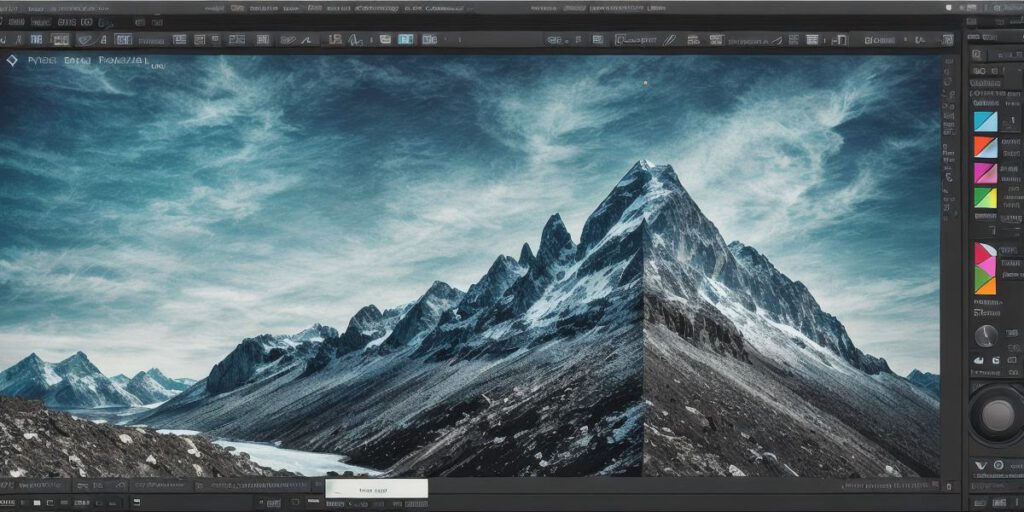What type of software do graphic designers typically use for their projects

Introduction
Graphic design is a crucial aspect of any business or personal project, from logos and websites to social media posts and marketing materials. With so many tools available on the market, it can be difficult for graphic designers to choose which software to use. This article aims to provide an overview of some of the most popular software options available for graphic designers in 2023, taking into consideration their features, user-friendliness, and overall effectiveness. We’ll also explore the pros and cons of each software and answer common questions.
Adobe Creative Suite

Adobe Creative Suite
is one of the most widely used software sets for graphic design. It consists of several applications, including Photoshop, Illustrator, InDesign, and Premiere Pro, among others. Each application has its own unique features and is designed for specific tasks, making it a versatile set of tools for any designer.
Photoshop is a powerful image editing software that allows designers to manipulate images, create digital art, and retouch photos. It’s a popular choice for photographers, graphic designers, and digital artists. Illustrator, on the other hand, is a vector graphics editor that allows designers to create logos, illustrations, and other types of designs. It’s particularly useful for creating detailed and scalable designs. InDesign is a desktop publishing software used for creating books, magazines, and other printed materials. Finally, Premiere Pro is a video editing software that can be used for creating high-quality videos and animations.
The biggest advantage of
Adobe Creative Suite
is its seamless integration with other Adobe products. For example, designers can easily transfer files between Photoshop and Illustrator or between InDesign and Premiere Pro. Additionally, the software has a wide range of advanced features that can be customized to suit individual design needs.
However, one downside of
Adobe Creative Suite
is its high cost. The monthly subscription for the entire suite can be quite expensive, especially for small businesses or freelancers who may only need a few of the applications. Additionally, the learning curve can be steep for beginners and take some time to master.
Figma
Figma
is a cloud-based graphic design software that has gained popularity in recent years due to its collaborative features. With
Figma
, designers can work on projects together in real-time, making it an excellent choice for remote teams or freelancers who need to communicate with clients in different time zones.
Figma
offers a wide range of tools and features, including vector graphics editing, image manipulation, prototyping, and collaboration. It’s particularly useful for creating user interfaces, websites, and mobile apps. One advantage of
Figma
is its ability to export files in multiple formats, making it easy to share projects with clients or stakeholders.
However, some users may find the interface a bit cluttered and confusing at first. Additionally, while
Figma
has many features, it’s not as powerful as
Adobe Creative Suite
for certain tasks such as image manipulation or 3D design.
Sketch
Sketch
is a digital design tool that is primarily used for creating user interfaces and website designs. It offers a wide range of features, including vector graphics editing, prototyping, and collaboration, making it an excellent choice for designers who need to create complex interfaces and user experiences.
One advantage of
Sketch
is its simple and intuitive interface, which makes it easy to learn and use for beginners. Additionally,
Sketch
has a strong focus on user experience design, with features such as auto-layout and interactive prototyping that make it easier to create responsive designs that work well on different devices.

However, one downside of
Sketch
is its limited range of tools compared to other software sets like
Adobe Creative Suite
. For example,
Sketch
doesn’t have image manipulation or photo editing features, which can be a limitation for some designers. Additionally, the software can be quite expensive, especially for small businesses or freelancers who may only need it for occasional projects.
Canva
Canva
is a graphic design tool that is primarily used for creating social media graphics, logos, and marketing materials. It’s an excellent choice for small businesses or freelancers who don’t have access to professional graphic design software.
Canva
has a simple and user-friendly interface that makes it easy to create designs even without any prior design experience. Additionally, it offers a wide range of templates and pre-designed elements that can be customized to suit individual needs.
However, one downside of
Canva
is its limited range of advanced features compared to professional software sets like
Adobe Creative Suite
or
Sketch
. For example,
Canva
doesn’t have image manipulation or photo editing features, which can be a limitation for designers who need more control over their designs. Additionally, the software may not be suitable for creating complex designs that require advanced features and functionality.
Pros and Cons of Each Software Set
Adobe Creative Suite
: Pros – Seamless integration with other Adobe products, wide range of advanced features customizable to suit individual design needs. Cons – High cost, steep learning curve for beginners.
Figma
: Pros – Collaborative features make it easy for remote teams to work together in real-time. Wide range of tools and features, ability to export files in multiple formats. Cons – Interface can be cluttered and confusing for beginners, not as powerful as
Adobe Creative Suite
for certain tasks.
Sketch
: Pros – Simple and intuitive interface, strong focus on user experience design, ability to create responsive designs that work well on different devices. Cons – Limited range of tools compared to other software sets, quite expensive, especially for small businesses or freelancers who may only need it for occasional projects.
Canva
: Pros – Simple and user-friendly interface, wide range of templates and pre-designed elements that can be customized to suit individual needs. Cons – Limited range of advanced features compared to professional software sets, not suitable for creating complex designs that require advanced features and functionality.
FAQs
Q: Which software set is the most suitable for a small business with limited budget?
A:
Canva
Q: What are some common features that distinguish professional graphic design software from free or low-cost options?
A: Advanced features such as image manipulation, photo editing, and vector graphics editing, ability to create complex designs and animations, seamless integration with other tools and applications.
Q: How can I choose the right software set for my design needs?
A: Consider your budget, experience level, and project requirements when choosing a software set. Look for software that has the features you need and is easy to use.
Summary
Graphic design is an essential aspect of any business or personal project. With so many software options available on the market, it can be difficult to choose the right one for your needs. This article provides a comprehensive guide to some of the most popular software sets for graphic designers in 2023, taking into consideration their features, user-friendliness, and overall effectiveness. By understanding the pros and cons of each software set and choosing one that best suits your needs, you can create high-quality designs that stand out from the competition.